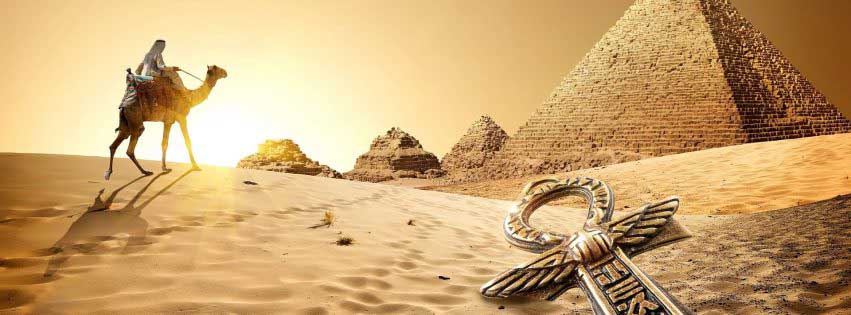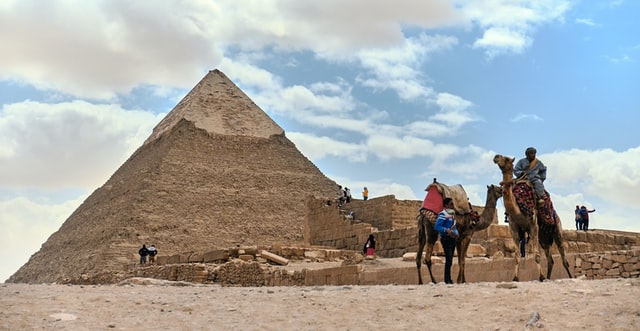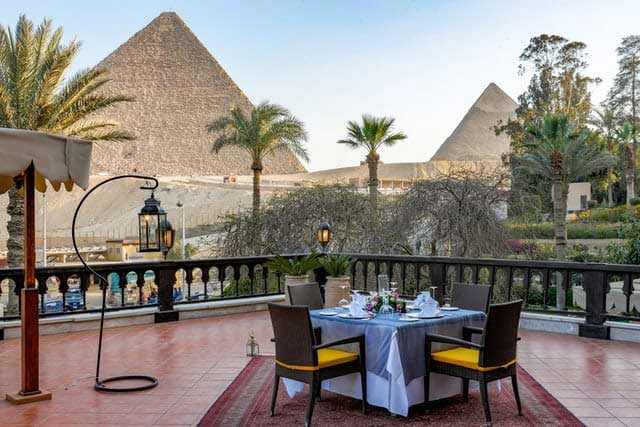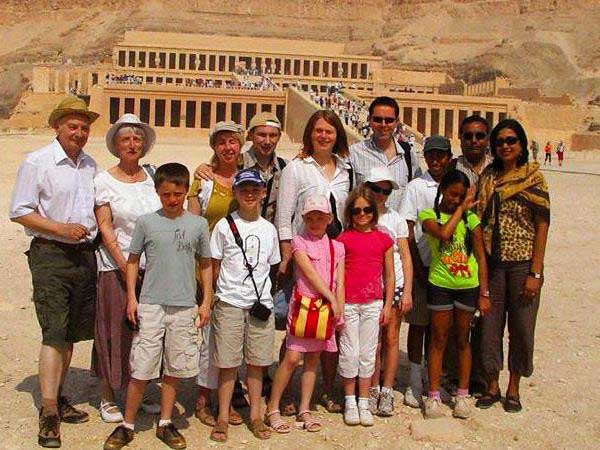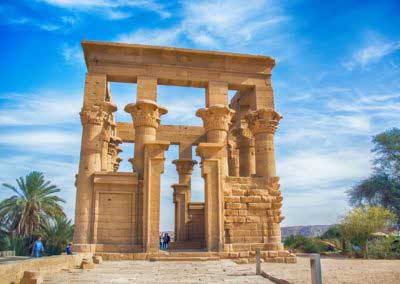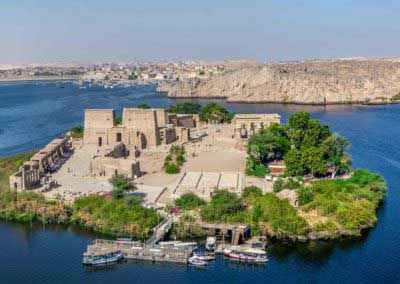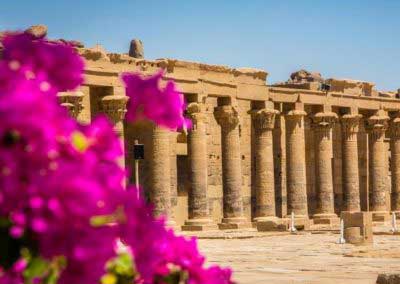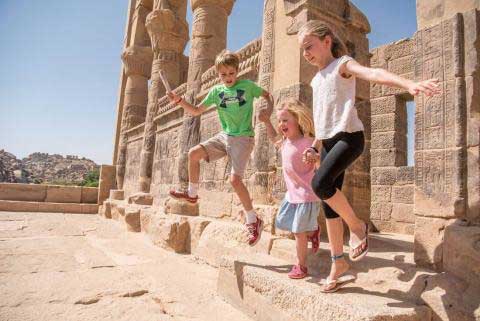
Philae Temple
Philae Temple : The ancient Egyptian name of Philae Island was Pilak, from which the Greek and Latin Philae was derived. During the Islamic era, it was known to the local people as El-Oasr, the “Castle,” or as Geziret Anas el-Wogud, after the hero of one of the tales in the “Arabian Nights,” who traced his beloved to the island, where she had been locked up by her father.
Ancient Egyptian texts refer to Philae as “the island of time.” The most ancient testimony of religious presence on the island dates back to the New Kingdom. Therefore, the first temple structure to be built on the island was assembled at the order of King Nectanebo, founder of the thirteenth dynasty, and was dedicated to Isis. Throughout time, the temple gained significance while the cult of Isis grew stronger all over Egypt, especially in the surrounding region.
Philae Temples were later empowered by the rulers of Alexandria. Under Ptolemy II Philadelphe , the revenues of the land extending 120 km to the south of the island were dedicated to the priests of Isis. Moreover, the rapids of the Nile in the area forced boats to land their goods and transport them overland, through Philae, which was another source of wealth that the priests exploited in order to strengthen their power.

Temple of Philae
The principal deity of the temple complex was Isis, but minor temples and shrines were dedicated to other deities like her son Horus in his several aspects ; such as his Greek form under the name of Harendotes, and his Nubian form, where he is Dedicated to the goddess Isis, the Temple of Philae is located in a beautiful setting, landscaped to match the original site of the temple when it was relocated by UNESCO after the building of the Aswan Dam threatened the site. The temple has several shrines and sanctuaries such as Trajan Kiosk or Pharaoh’s Bed. Visit the temple at night to attend the Sound and Light show.
Located just above the First Cataract of the Nile, Philae lies only a few meters away from its twin, Biggeh, which was thought to be one of the burial place of Osiris , and was therefore highly revered by the Egyptians in ancient times. It was called “the pure island” and “an unapproachable place” because no one but priests could live there or visit the island. It was also thought that birds would not fly over it and that fish would not swim near its shorescalled Mandoulis.
Another important shrine is dedicated to the famous egyptian architect Imhotep (builder of Saqqara pyramid) under the Greek name of Asklepius. For centuries, the temple complex was the holiest site for Isis worshippers . It used to be believed that the temple was officially closed down in the 6th century A.D. by the Byzantine emperor, Justinian (527-565 AD), but recent research on the history of the Isis religion has proved that the cult remained active until the ninth century.
In fact, Philae in Egypt and Baalbak in Lebanon were the two last bastions of pagan religion in the Middle East. At this time, within the Philae complex, a church occupied the hypostyle hall in the heart of Isis temple (where we can see the foundation decree signed by Apa Theodore on 537), an Islamic minaret called «Mi’zanet Bilal» had been erected on the western portion of the island to serve Muslim merchants passing through the region, and a few poor remaining priests of Isis wandered around trying to survive off of the lingering Nubian zealots and the last of the pilgrims to the sanctuary.
The History of the Temple of Isis
From early Egyptian times the island was sacred to the goddess Isis; the earliest structures known are those of Taharqa (reigned 690–664 BCE), the Cushite 25th-dynasty pharaoh. The Saites (664–525 BCE) built the earliest-known temple, found dismantled and reused in the Ptolemaic structures. Nectanebo II (Nekhtharehbe [reigned 360–343 BCE]), last pharaoh of the 30th dynasty and last independent native ruler of Egypt prior to 1952, added the present colonnade. The complex of structures of the Temple of Isis was completed by Ptolemy II Philadelphus (reigned 285–246 BCE) and his successor, Ptolemy III Euergetes (fl. 246–221 BCE). Its decorations, dating from the period of the later Ptolemies and of the Roman emperors Augustus and Tiberius (30 BCE–37 CE), were, however, never completed. The Roman emperor Hadrian (reigned 117–138 CE) added a gate west of the complex. Other small temples or shrines dedicated to Egyptian deities include a temple to Imhotep and one to Hathor, as well as chapels to Osiris, Horus, and Nephthys.
The Temple of Isis continued to flourish during Roman times and was not closed until the reign of Justinian I (527–565 CE). Late in Justinian’s reign the temple was converted into a church, and two other Coptic churches were built in the still-prosperous town.
All these structures were thoroughly explored and reinforced (1895–96) before being partially flooded behind the old Aswan Dam. In 1907 a careful inspection revealed that salts in the water were harming paints on the decorations. When the temples reemerged after 1970 with the completion of the High Dam upstream, it was found that considerable damage had been done to the shrines. A decision was therefore made to remove them to higher ground on the nearby island of Agilkia. The island was leveled to resemble the original Philae, and the temples were rebuilt, restoring to them some measure of their original beauty prior to their formal reopening in 1980.
The construction of Isis Temple
The Temple of Isis is one of the greatest Temples in Egypt and it occupies about a quarter of the island. It is also the temple’s main island with its huge, complete, pylons and beautiful scenes.
The construction began during the reign of King Ptolemy II, and then other Ptolemaic Kings (Ptolemy’s IV, V, VI, VII, and XI) contributed by adding more parts to the main Temple.
The Temple is built in the same style as the Temples of the New Kingdom, as well as some other elements, which appeared in the Greco-Roman period, such as the Mamisi (the House of the divine birth of Horus), and a Nilometer.
The Temple of Isis consists of the 1st Pylon, which is a great traditional pylon with two towers, and an open forecourt, which leads to the 2nd pylon. On the left side of this court is the Mamisi, which has scenes depicting the birth of the God Horus by his mother Isis.
The 2nd Pylon leads to a Hypostyle Hall with 10 columns, and then 3 vestibules leading to a sanctuary.
The oldest remains of the Temple of Philae date back to the reign of King Taharqa (25th Dynasty), who built the first chapel for the Goddess Isis.
There are other monuments here, as well, including The Kiosk of Trajan, the Chapel of Osiris, The Temple of Horus, The Temple of Hathor, The Gateway of Tiberius, the Gateway of Diocletian, and the Temple of Augustus.
The temples of the island were neglected, and some of them even destroyed, after the persecution of the Christians by the Roman Emperors. During the reign of the Emperor Justinian (527-565 A.D), the main Temple was converted to a church.
Philae in Danger: Philae and the High dam
Philae was first threatened by the Nile’s waters in 1902 when the Aswan Dam was completed on the Nile River. The dam was heightened twice, from 1907-12 and from 1929-34, at which point the island of Philae was nearly always flooded. Because of the damage that this constant water exposure was having on the temple, it was thought that the temples should be relocated, piece by piece, to a nearby island. Rather than carrying out this plan at that time, the temples’ foundations and other architectural supporting structures were strengthened instead. Although the buildings were physically secure, the island’s attractive vegetation and the colors of the temples’ reliefs had been washed away. Still subjected to the river’s lapping, the bricks of the Philae temples soon became encrusted with silt and other debris carried by the Nile.
Saving Philae Temple: The Rescue mission
By the 1960’s, the island of Philae was submerged all year round 12 . In a spectacular operation that gathered the efforts of more than 50 countries, the temples of Philae were rescued by dismantling the blocs and transferring them to another island in the area called Agilika 13 . The work started immediately after the International appeal launched from UNESCO headquarters in Paris on November 6th, 1968. In order to relocate the Temple of Philae, a large coffer dam was built encircling the island with the two rows of steel plates constructed between which a million cubic meters of sand was tipped. Once the water covering its base was pumped away, the monuments were cleaned and measured using Photogrammetry, a method that enables the exact reconstruction of the original building blocks that were used by the ancients. The salvage operation took almost 10 years (1970-1980).
Two years later, the newly appointed Egyptian President Anwar Sadat, showed his appreciation for the efforts in a speech he gave on December 19th, 1970 to celebrate the salvage work that had been done the region and to voice his appreciation for the spirit of cooperation the initiative had created.
Conservation and Preservation of the Island
Philae is part of the Heritage site of Nubia: From Aswan to Abu Simbel, inscribed in 1979 on the World Heritage List. Recently, the Ministry of Antiquities executed a site management plan to protect the Island. You too can help us to protect these historical monuments by respecting these guidelines :
- please do not write on walls, nor on the signs posted throughout the site
- please look but do not touch the reliefs because they are fragile
- please do not throw rubbish on the ground ; dispose of trash properly
Frequently asked questions about visiting Philae Island
What does Philae mean?
What does Philae mean?
What are the powers of Isis?
What are the powers of Isis?
Why was the Temple of Philae built?
Why was the Temple of Philae built?
Where is the temple of Philae located?
Where is the temple of Philae located?
How old is Philae Temple?
How old is Philae Temple?
How old is Philae Temple?
How old is Philae Temple?
Who is Isis the goddess?
Who is Isis the goddess?
When was Philae Temple built?
When was Philae Temple built?
What are the best tours in Aswan?
What are the best tours in Aswan?
These experiences are the best in Aswan Visiting Philae temple. Aswan High Dam, and the Unfinished Obelisk Private Day Tour to Abu Simbel Temples from Aswan 2 nights Nile cruise includes tours from Aswan to luxor 4-Day 3-Night Nile Cruise from Aswan to Luxor – Private Tour Aswan day tour from Marsa Alam 2 days trip to Aswan and Abu Simbel from Marsa Alam 2 days trip to Aswan and Abu Simbel from Hurghada Kalabsha temple and the Nubian museum tourIs it safe to travel to Egypt
Is it safe to travel to Egypt?
Is Egypt Safe for Americans to Travel to
Is Egypt Safe for Americans to Travel to?
We get this question a lot at Bastet Travel In short, Americans and other visitors can rest easy: yes, Egypt is a safe country for tourists. And the rest of the world seems to agree — after years of middling numbers, tourism in Egypt is steadily rising towards its former highs, hosting over 9 million sightseers in 2018. The longer answer is worth exploring, though, and we have some assurances to offer all our clients who join us on all of our Egypt Travel Packages.How far is Abu Simbel from Luxor?
How far is Abu Simbel from Luxor?
The distance between Luxor and Abu Simbel temples is 388 km. The road distance is 477.5 km.What are the best tours in Luxor?
What are the best tours in Luxor?
How do you get to Luxor?
How do you get to Luxor?
Related Articles
Related
Best places to visit in Egypt
Are you currently planning a trip? Are you wondering what are the best places to visit in Egypt? What is the best time to visit Egypt or where to stay in Egypt?
How lucky you are, you have just found your ultimate guide.
Egypt is considered the oldest travel destination on globe. In a land where the past sits overlooking the present, Egypt is a country that fills the senses. Egypt is a land with well-defined boundaries. To the east and west are vast deserts. To the north is the Mediterranean sea. To the south is the land of Nubia.
Egypt has amassed approximately 7000 years of history and civilization; but besides its breathtaking Pharaonic and other ancient attractions, Egypt also currently possesses unique cultures, traditions, food, people and, exciting activities. For centuries, tourists have flocked to Egypt to admire its ancient pyramids and temples. The country also has its fair share of natural wonders. The River Nile is the longest in the world, and the Red Sea coast is a playground for resort-style relaxation and adventurous watersports.
Seth
Also known as Set, Setekh, Suty and Sutekh, Seth was the god of chaos, darkness, violence, evil, deserts, storms, and one of the Osirian gods. In the Osiris myth, he is the murderer of Osiris (in some versions of the myth, he tricks Osiris into laying down in a coffin and then seals it shut.)
Ancient Egyptian Gods And Goddesses
For all ancient Egyptians, the world was filled with mystery. Much of what they experienced in the world around them was unknowable and frightening. The ancient Egyptian gods and goddesses represented aspects of the Egyptians’ natural and “supernatural” surroundings and helped them understand its many aspects.
Horus
Depicted as a falcon or as a man with a falcon’s head, Horus was a sky god associated with war and hunting. He was also the embodiment of the divine kingship, and in some eras the reigning king was considered to be a manifestation of Horus.



